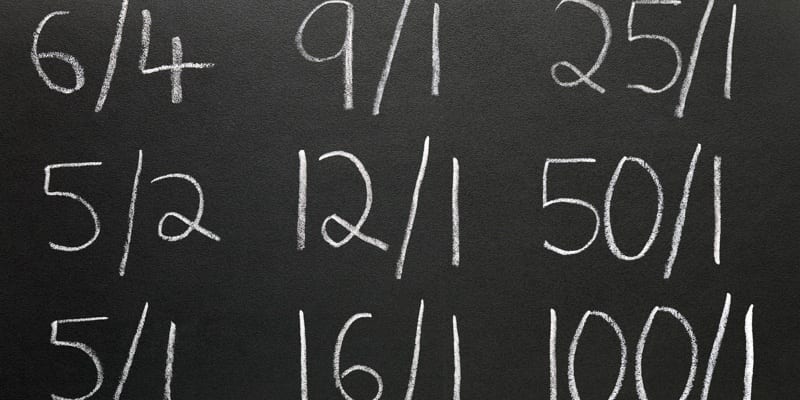
Betting odds show you the probability of an event happening and from this, you can calculate your winnings.

Betting odds show you the probability of an event happening and from this, you can calculate your winnings.
As a very quick example, if odds are 3/1, for every $1 you bet, you will win $3 plus the stake back. With odds at 3/1 there is a 25% chance that this may happen and to calculate this 1 / (3 + 1) x 100 = 25%.
As another slightly more complicated betting example, if the event odds are 5/2 your bet would have a 28.57% chance of winning. The formula to calculate the percentage of a winning outcome based on these odds would be 2 / (2 + 5) x100 = 28.57%.
As a finale example, bookmaker odds at 11/5 would be calculated as follows:
5 / (5 + 11) x100 = 31.25%.
That’s the quick betting explanation out of the way but you may be new to betting and not fully understand how betting odds work, especially some of the terminology used, like decimal odds and fractional odds.
If this is the case then you’ve come to the right place as I’d like to give you the full lowdown in this guide to betting, so you have a good understanding if your bet has a chance of having the desired outcome.
Betting odds are the probability of a chosen event occurring, betting odds are displayed as either fractions or decimals and from this you can calculate your winnings when betting.
When it comes to betting, regardless of if it’s horse racing, football or whatever your favourite betting event may be, it’s important to know how betting odds work otherwise you cannot calculate any potential returns.
This is less important when using an app or website whilst betting as the odds are displayed on the virtual betslip and the outcome should you win is calculated for you.
If you attend a live horse racing event though and are betting at the racecourse then working out the horse racing odds is good knowledge to have.
If you are US based and listen to any bookmaker that is on the radio or TV they usually quote sports betting odds as fractional and it’s the most popular odds form in Britain. However, fractional odds can be really confusing when it comes to calculating odds in your head. Fractions aren’t as friendly an odds format as decimal odds which are common when betting in the of Europe, betting in Canada and or betting in Australia.
Let me use a quick betting example to explain what I mean. If you place a horse racing bet at odds of 11/4 and then the betting odds change to 13/4 is that better or worse for you as a punter?
Without reaching for my calculator I couldn’t work it out, so when it comes to calculating your potential return then picking the betting odds format you can understand is key. Especially if you are engadged in something like matched betting which requires you to make quick decision on any given event.
Decimal betting odds are much easier to work out, so if we convert the fractional odds above to decimal odds then 11/4 becomes 3.75 (11 divided by 4 plus 1) and 13/4 becomes 3.6 (12 divided by 4 plus 1).
So which is a bigger number 3.75 or 3.6? It’s much simpler to calculate a return on your betting using decimal odds.
The great thing is that the bookmaker will display the betting odds for you if you are placing a bet using their website or on your mobile or tablet. If you wish to change the format then you can visit the My Account section of the site and it’s really simple to flip between fractions and decimal odds, making it much easier to work out your return.
It is also known as moneyline odds or US odds and are most popular in the United States. The odds are displayed with a negative (-) sign and a positive (+) sign.
Calculating your potential winnings can be confusing if you aren’t used to betting in this format but it’s worth noting that whatever odds format is displayed the winnings are the same regardless.
To calculate a return here is an example for you to look at:
In an event between Team A vs Team B you may see odds displayed as +112 for Team A and – 124 for Team B.
What this means first and foremost is that the Team B are the favourites as they have a minus number. To calculate a return on the quoted odds I would need to bet $124 on Team B to return $100 profit and if I was to bet $100 on Team A it would return $112.
When I decided to write this Betting Odds Explained article I wanted to make sure I covered all the type of odds in betting.
The bookmaker uses data to calculate betting odds based on the total amount of bets placed and what their liabilities are. As more money is wagered on different outcomes the odds are adjusted accordingly. Different betting shops will offer different odds based on their risk.
Some of the betting odds may form some promotion that the bookmaker is running like best odds guaranteed, which means that regardless of the betting odds you have been quoted the bookmaker will match it.
Fractional decimal, odds fractional these are just some of the confusing terminology when looking at odds on betting and it’s easy to become really confused.
Hopefully this Betting Odds Explained article has given you a better idea of how to best calculate odds and you don’t feel like to need to be some horse racing genius to work out your winnings.